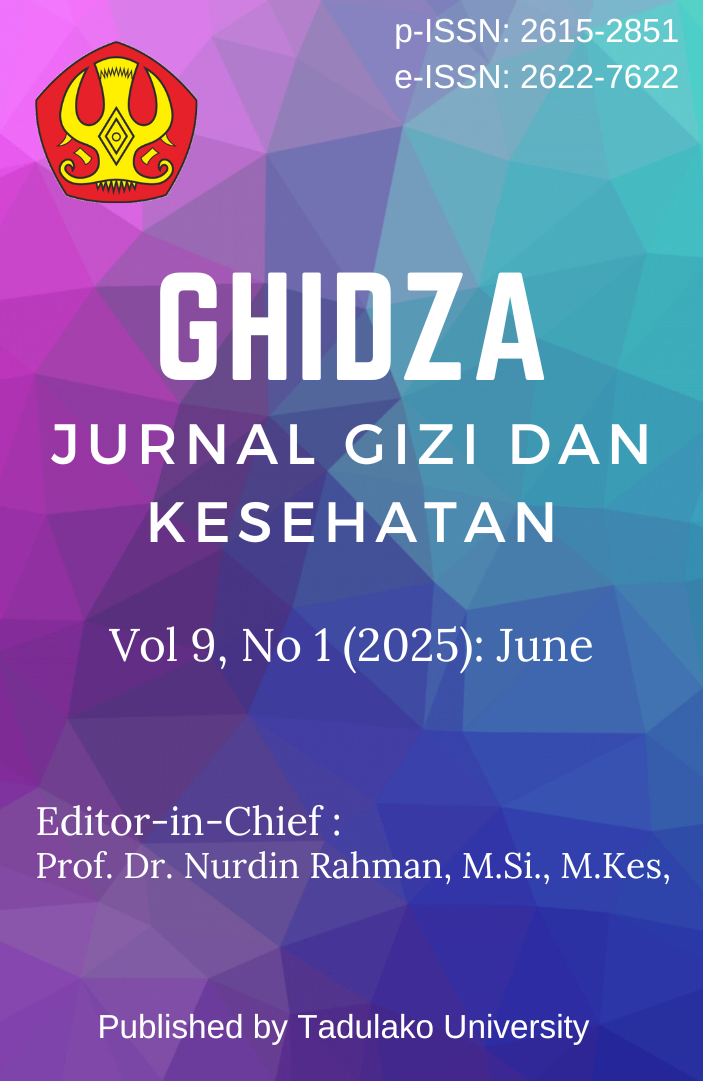Faktor-Faktor yang Berhubungan dengan Perilaku Picky Eating pada Balita Usia 24-59 Bulan
DOI:
https://doi.org/10.22487/ghidza.v9i1.1879Keywords:
Picky Eating, Balita, Masalah GiziAbstract
Picky eating pada balita usia 24-59 bulan dapat mengakibatkan masalah gizi. Hal ini dikarenakan balita akan memilih-milih atau bahkan menolak makanan sehingga asupan zat gizi tidak terpenuhi. Banyak penyebab munculnya masalah picky eating pada balita, antara lain umur balita, jumlah kelahiran, pemberian ASI, dan pendidikan ibu. Tujuan utama dari penelitian ini adalah menganalisis faktor-faktor yang berhubungan dengan perilaku picky eating pada balita. Penelitian ini menggunakan desain cross sectional. Sampel penelitian, yaitu balita usia 24-59 bulan berjumlah 366 orang yang dipilih menggunakan teknik accidental sampling. Variabel bebas yang diteliti, yaitu jenis kelamin, Pendidikan orang tua, jumlah balita dalam rumah, riwayat ASI eksklusif, inisiasi menyusui dini, berat badan lahir, dan riwayat sakit dalam 6 bulan terakhir, sedangkan variabel terikat adalah perilaku picky eating. Analisis data yang digunakan adalah chi square. Variabel yang berhubungan dengan perilaku picky eating pada balita, yaitu ASI eksklusif (p value = 0,000), BBLR (p value = 0,008), dan riwayat sakit (p value = 0,001). Variabel-variabel yang tidak berhubungan dengan perilaku picky eating pada balita, yaitu jenis kelamin (p value = 0,918), pendidikan ayah (p value = 0,398), pendidikan ibu (p value = 0,054), jumlah balita (p value = 0,752), dan IMD (p value = 0,122). Variabel yang berhubungan dengan perilaku picky eating pada balita, yaitu pemberian ASI eksklusif, BBLR, dan riwayat sakit. Para ibu sebaiknya memberikan makanan yang bervariasi agar balita tidak bosan dengan bentuk dan rasa makanan sehari-hari.
Downloads
References
2. Antoniou, E. E., Roefs, A., Kremers, S. P. J., Jansen, A., Gubbels, J. S., Sleddens, E. F. C., & Thijs, C. (2016). Picky eating and child weight status development: A longitudinal study. Journal of Human Nutrition and Dietetics, 29(3), 298–307. https://doi.org/10.1111/jhn.12322
3. Ariyanti, F. W., Fatmawati, A., & Sari, I. P. (2023). Faktor yang Berhubungan dengan Picky Eating pada Anak Usia Prasekolah. Amerta Nutrition, 7(1SP), 8–11. https://doi.org/10.20473/amnt.v7i1sp.2023.8-11
4. Asfaw, M., Wondaferash, M., Taha, M., & Dube, L. (2015). Prevalence of undernutrition and associated factors among children aged between six to fifty nine months in Bule Hora district, South Ethiopia. BMC Public Health, 15(1), 1–9. https://doi.org/10.1186/s12889-015-1370-9
5. Cano, S. C., Tiemeier, H., Van Hoeken, D., Tharner, A., Jaddoe, V. W. V., Hofman, A., Verhulst, F. C., & Hoek, H. W. (2015). Trajectories of picky eating during childhood: A general population study. International Journal of Eating Disorders, 48(6), 570–579. https://doi.org/10.1002/eat.22384
6. Cerdasari, C., Puspita, T., & Adelina, R. (2018). Effect of “Bento” preparation training on mothers knowledge, skill, and child’s picky eating. Jurnal Gizi Dan Dietetik Indonesia, 6(2), 43–50. https://doi.org/10.21927/ijnd.2018.6(2).43-50
7. Chao, H. C. (2018). Association of picky eating with growth, nutritional status, development, physical activity, and health in preschool children. Frontiers in Pediatrics, 6(22), 1–9. https://doi.org/10.3389/fped.2018.00022
8. Cole, N. C., An, R., Lee, S. Y., & Donovan, S. M. (2017). Correlates of picky eating and food neophobia in young children: A systematic review and meta-analysis. Nutrition Reviews, 75(7), 516–532. https://doi.org/10.1093/nutrit/nux024
9. de Barse, L. M., Jansen, P. W., Edelson-Fries, L. R., Jaddoe, V. W. V., Franco, O. H., Tiemeier, H., & Steenweg-de Graaff, J. (2017). Infant feeding and child fussy eating: The Generation R Study. In Appetite (Vol. 114). Elsevier Ltd. https://doi.org/10.1016/j.appet.2017.04.006
10. De Lauzon-Guillain, B., Jones, L., Oliveira, A., Moschonis, G., Manios, Y., Xepapadaki, P., Lopes, C., Moreira, P., Charles, M. A., & Emmett, P. (2013). The influence of early feeding practices on fruit and vegetable intake among pre-school children in four European birth cohorts. America Journal Clinical Nutrition, 98(10), 804–812. https://doi.org/10.1017/S1368980014002390
11. Etikan, I., Musa, S. A., & Alkassim, R. S. (2016). Comparison of Convenience Sampling and Purposive Sampling. American Journal of Theoretical and Applied Statistics, 5(1), 1–4. https://doi.org/10.11648/j.ajtas.20160501.11
12. Fries, L. R., & Van Der Horst, K. (2019). Parental Feeding Practices and Associations with Children’s Food Acceptance and Picky Eating. Nestle Nutrition Institute Workshop Series, 91, 31–39. https://doi.org/10.1159/000493676
13. Goh, D. Y. T., & Jacob, A. (2012). Perception of picky eating among children in Singapore and its impact on caregivers: A questionnaire survey. Asia Pacific Family Medicine, 11(1), 1–8. https://doi.org/10.1186/1447-056X-11-5
14. Hardianti, R., Dieny, F. F., & Wijayanti, H. S. (2018). Picky eating dan status gizi pada anak prasekolah. Jurnal Gizi Indonesia (The Indonesian Journal of Nutrition), 6(2), 123–130. https://doi.org/10.14710/jgi.6.2.123-130
15. Hardini, N. E., & Wirjatmadi, B. (2024). Association between Picky Eater Behavior with Stunting among Preschool Children in Surabaya. Media Gizi Indonesia, 19(2), 140–147. https://doi.org/10.20473/mgi.v19i2.140-147
16. Hegazi, M. A., Sehlo, M. G., Al-Jasir, A., & El-Deek, B. S. (2015). Development and cognitive functions in Saudi pre-school children with feeding problems without underlying medical disorders. Journal of Paediatrics and Child Health, 51(9), 906–912. https://doi.org/10.1111/jpc.12880
17. Kemenkes RI. (2018). Hasil Riset Kesehatan Dasar Tahun 2018. Kementrian Kesehatan RI, 53(9), 1689–1699.
18. Kemenkes RI. (2018). Riskesdas 2018 Provinsi NTT. In Kemenkes RI.
19. Kumar, R. K., Singhal, A., Vaidya, U., Banerjee, S., Anwar, F., & Rao, S. (2017). Optimizing Nutrition in Preterm Low Birth Weight Infants—Consensus Summary. Frontiers in Nutrition, 4, 1–9. https://doi.org/10.3389/fnut.2017.00020
20. Lumeng, J. C., Miller, A. L., Appugliese, D., Rosenblum, K., & Kaciroti, N. (2018). Picky eating, pressuring feeding, and growth in toddlers. Appetite, 123, 299–305. https://doi.org/10.1016/j.appet.2017.12.020
21. Machado, B. C., Dias, P., Lima, V. S., Campos, J., & Gonçalves, S. (2016). Prevalence and correlates of picky eating in preschool-aged children: A population-based study. Eating Behaviors, 22, 16–21. https://doi.org/10.1016/j.eatbeh.2016.03.035
22. Mahumud, R. A., Sultana, M., & Sarker, A. R. (2017). Distribution and determinants of low birth weight in developing countries. Journal of Preventive Medicine and Public Health, 50(1), 18–28. https://doi.org/10.3961/jpmph.16.087
23. Mok, K. T., Tung, S. E. H., & Kaur, S. (2022). Picky Eating Behaviour, Feeding Practices, Dietary Habits, Weight Status and Cognitive Function Among School Children in Kuala Lumpur, Malaysia. Malaysian Journal of Medicine and Health Sciences, 18(4), 10–18. https://doi.org/10.47836/mjmhs18.4.3
24. Nurmalasari, Y., Utami, D., & Perkasa, B. (2020). Picky Eating and Stunting in Children aged 2 to 5 years in Central Lampung, Indonesia. Malahayati International Journal of Nursing and Health Science, 03(1), 29–34.
25. Okubo, H., Miyake, Y., Sasaki, S., Tanaka, K., & Hirota, Y. (2016). Feeding practices in early life and later intake of fruit and vegetables among Japanese toddlers: The Osaka Maternal and Child Health Study. Public Health Nutrition, 19(4), 650–657. https://doi.org/10.1017/S1368980015001779
26. Oliveira, A., De Lauzon-Guillain, B., Jones, L., Emmett, P., Moreira, P., Ramos, E., Charles, M. A., & Lopes, C. (2015). Birth weight and eating behaviors of young children. Journal of Pediatrics, 166(1), 59–65. https://doi.org/10.1016/j.jpeds.2014.09.031
27. Paintal, K., & Aguayo, V. M. (2016). Feeding practices for infants and young children during and after common illness. Evidence from South Asia. Maternal and Child Nutrition, 12, 39–71. https://doi.org/10.1111/mcn.12222
28. Patel, M. D., Donovan, S. M., & Lee, S. Y. (2020). Considering nature and nurture in the etiology and prevention of picky eating: A narrative review. Nutrients, 12(11), 1–18. https://doi.org/10.3390/nu12113409
29. Purnamasari, A. R., & Adriani, M. (2020). Hubungan perilaku picky eater dengan tingkat kecukupan protein dan lemak pada anak prasekolah. Media Gizi Indonesia, 15(1), 31–37. https://doi.org/10.20473/mgi.v15i1.31-37
30. Qazaryan, K. S. Y., & Kazim Karim, S. (2019). The clinical link of preschoolers’ picky eating behavior with their growth, development, nutritional status, and physical activity in Iraq/Kurdistan region. Neurology and Neuroscience Reports, 2(1), 1–8. https://doi.org/10.15761/nnr.1000115
31. Samuel, T. M., Musa-Veloso, K., Ho, M., Venditti, C., & Shahkhalili-Dulloo, Y. (2018). A narrative review of childhood picky eating and its relationship to food intakes, nutritional status, and growth. Nutrients, 10(12), 1–30. https://doi.org/10.3390/nu10121992
32. Shettiwar, S., & Wade, M. (2019). Correlates of picky eating behaviour in children and its effect on growth. International Journal of Contemporary Pediatrics, 6(6), 2444. https://doi.org/10.18203/2349-3291.ijcp20194547
33. Specht, I. O., Rohde, J. F., Olsen, N. J., & Heitmann, B. L. (2018). Duration of Exclusive Breastfeeding May be Related to Eating Behaviour and Dietary Intake in Obesity Prone Normal Weight Young Children. PLOS One, 13(7), 1–11.
34. Syaiful, Y., Fatmawati, L., & Sholikhah, S. (2019). Stimulasi Oral Meningkatkan Reflek Hisap Pada Bayi Berat Lahir Rendah (BBLR). Journals of Ners Community, 10(01), 20–28.
35. Syarfaini, S., Nurfatmi, R., Jayadi, Y. I., & Alam, S. (2022). Hubungan Asupan Zat Gizi Makro Terhadap Kejadian Wasting pada Balita Usia 0-59 Bulan di Kecamatan Polombangkeng Utara Kabupaten Takalar Tahun 2022. Ghidza: Jurnal Gizi Dan Kesehatan, 6(2), 128–138. https://doi.org/10.22487/ghidza.v6i2.524
36. Taylor, C. M., & Emmett, P. M. (2019). Picky eating in children: Causes and consequences. Proceedings of the Nutrition Society, 78(2), 161–169. https://doi.org/10.1017/S0029665118002586
37. van der Horst, K., Deming, D. M., Lesniauskas, R., Carr, B. T., & Reidy, K. C. (2016). Picky eating: Associations with child eating characteristics and food intake. Appetite, 103, 286–293. https://doi.org/10.1016/j.appet.2016.04.027
38. Xue, Y., Lee, E., Ning, K., Zheng, Y., Ma, D., Gao, H., Yang, B., Bai, Y., Wang, P., & Zhang, Y. (2015). Prevalence of picky eating behaviour in Chinese school-age children and associations with anthropometric parameters and intelligence quotient. A cross-sectional study. Appetite, 91, 248–255. https://doi.org/10.1016/j.appet.2015.04.065
39. Xue, Y., Zhao, A., Cai, L., Yang, B., Szeto, I. M. Y., Ma, D., Zhang, Y., & Wang, P. (2015). Growth and development in Chinese pre-schoolers with picky eating behaviour: A cross-sectional study. PLoS ONE, 10(4), 1–16. https://doi.org/10.1371/journal.pone.0123664
Downloads
Published
Issue
Section
License
Ghidza: Jurnal Gizi dan Kesehatan is licensed under a Creative Commons Attribution-Share Alike 4.0 International License
All articles published Open Access are free for everyone to read and download. Under the CC-BY-SA license, authors retain ownership of the copyright for their article, but authors grant others permission to use the content of publications in Ghidza: Jurnal Gizi dan Kesehatan in whole or in part provided that the original work is properly cited.
Users (redistributors) of Ghidza: Jurnal Gizi dan Kesehatan are required to cite the original source, including the author's names, Ghidza: Jurnal Gizi dan Kesehatan as the initial source of publication, year of publication, and volume number.














.png)

.png)
1.png)



